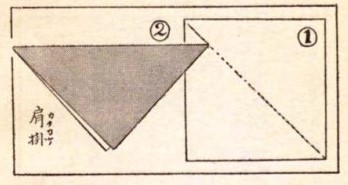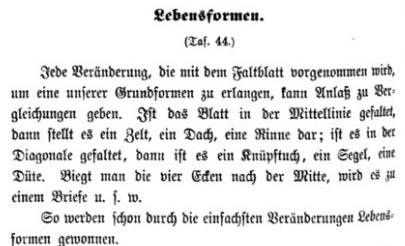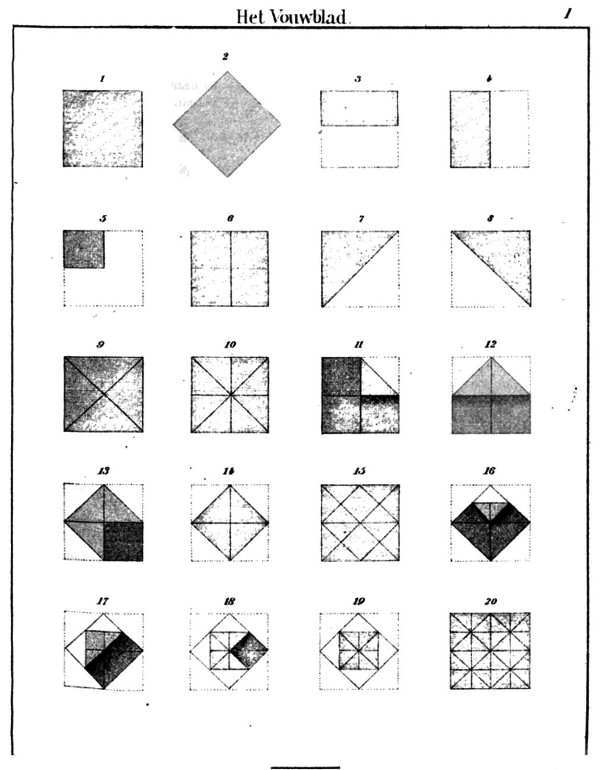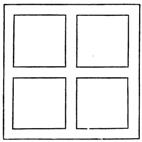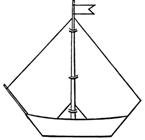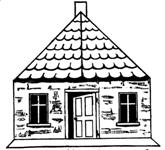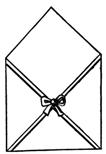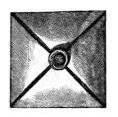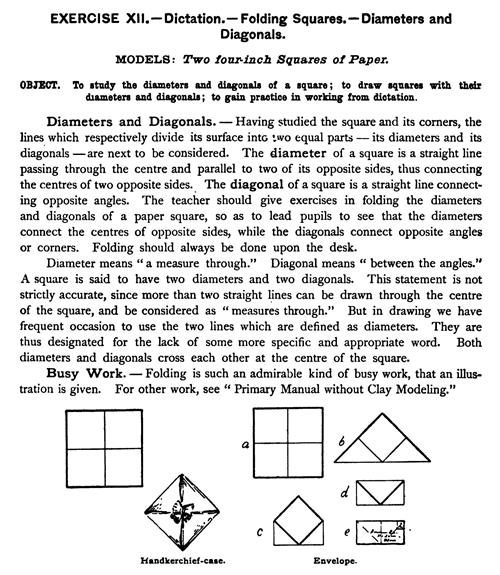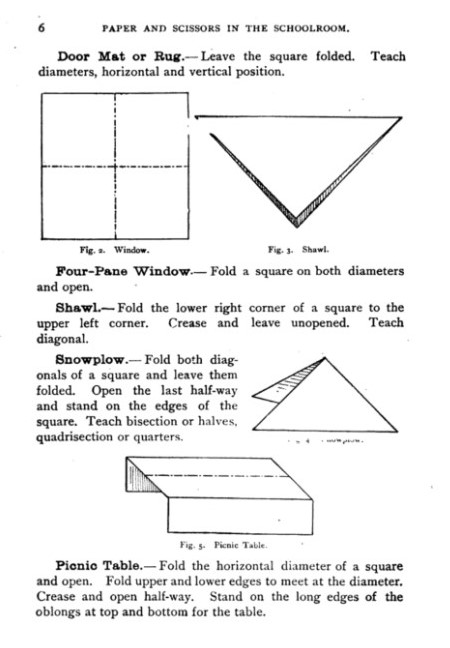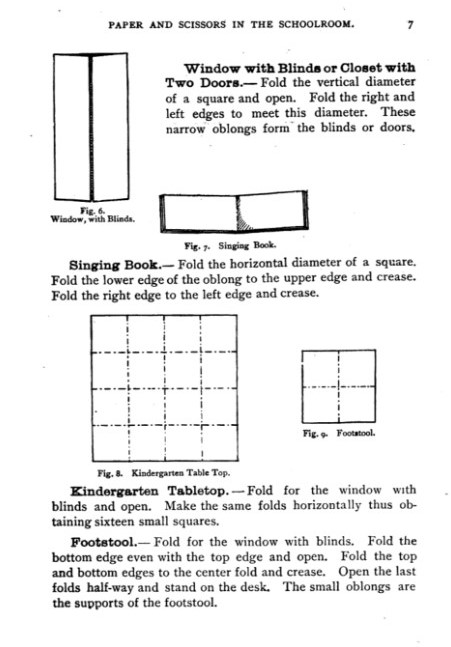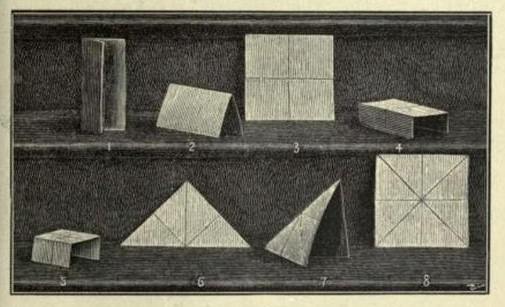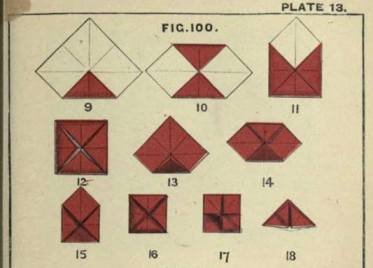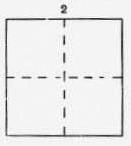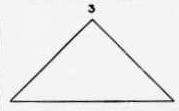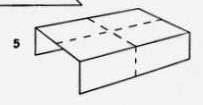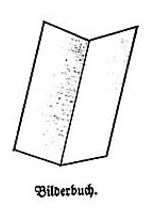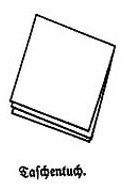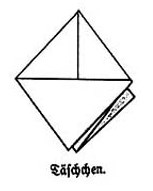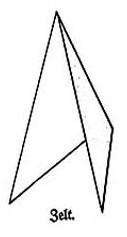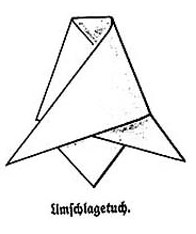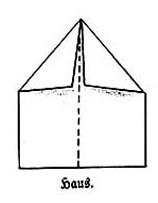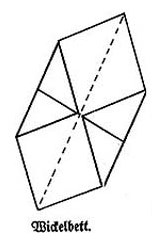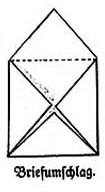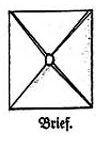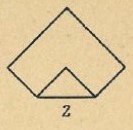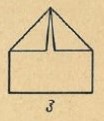| The Public Paperfolding History Project
Last updated 31/10/2025 x |
|||||||
| Falten - Simple Folds of Life | |||||||
This page is being used to collect information about the history of Simple Folds of Life (which do not otherwise have their own individual design pages). Please contact me if you know any of this information is incorrect or if you have any other information that should be added. Thank you. Simple Folds of Life are essentially basic or preliminary folds which have been given the names of objects that they resemble in order to make them more interesting / memorable to kindergarten pupils. They are not minimalist paperfolds (ie attempts to represent subjects using the minimum number of folds). As far as I know there is no evidence to suggest that Froebel himself conceived of these basic folds as Folds of Life (although, of course, he may have done so). Designs of this kind are frequently held together with stitches. ********** In Japan (and in books by Japanese authors) 1944 A design titled 'Katakake' (Shoulder Bag) appears in 'Origami Shuko' by Isao Honda, which was published in 1944. This is not presented as a Fold of Life.
********** In Europe and the Americas 1863 As far as I know the idea of giving simple folds names and thus treating them as Folds of Life first appears in 'Katechismus der praktischen Kindergärtnerei' by Friedrich Seidel, which was published by J J Weber in Leipzig in 1863. The text states: 'The whole is a square envelope, this a life form. Unfolding one of these squares (surely triangle) transforms the envelope into a house.'
********** 1879 There is mention of the closed envelope in 'Paedagogische Bibliotheek VI: Frobel' by J Versluys, which was published by W Versluys in Groningen in 1879. ********** Simple Folds of Life also appear: 1873 In 'Exercices et Travaux pour les Enfants Selon la Méthode et les Procédés de Pestalozzi et de Froebel' by Fanny and Charles Delon, which was published by Librairie Hachette in Paris in 1873. ********** 1874 In the third 'revised and enlarged' edition of 'Der Kindergarten' by Hermann Goldammer, which was published by Carl Babel in Berlin in 1874. The introduction to this section states, roughly, 'Any change that is made to the square in order to obtain one of the basic forms can give rise to comparisons. If the square is folded in the centre (ie edge to edge) it represents a picture, a roof, a gutter. If it is folded diagonally then it is a handkerchief, a sail, a bag. If you fold the four corners to the centre it becomes a letter, and so on. In this way forms of life are already achieved through the simplest changes.'
********** 1875 In the second edition of 'Praktischer Wegweiser fur den Unterricht in der Elementarklasse' (Practical Guide for Teaching in the Elementary Class) by Anton Fruhwirth, Alois Fellner and Georg Ernst which was first published by A Pichler's Witwe & Sohn in Vienna in 1875, the text says: 'By unfolding one part (ie one flap of a blintzed square) ... a house is created' and 'The unfolded parts can now lie in the plane of the square (ie completely unfolded) or have an inclination towards it. The square is placed on the triangles that have ben opened upright (Table with tablecloth) ... Other shapes cannot easily be described, they must rather be learned practically' and 'The folded sheet ... forms a roof by tilting and positioning the parts'. ********** In 'Froebels Methode' by Elise Van Calcar, which was published in 1875. Plate I illustrates a folding sequence that explores some of the properties of the folded square and ends, at figure 19, with the Double Blintz Basic Form. Some of the intermediate forms are given names / treated as Simple Folds of Life: Figure 6 is 'a window with four panes of glass'. Figure 7 is 'a bag, or a pepper shaker, or a scarf for a doll'. Figure 10 is 'a beautiful star' (the waterbomb base, made by folding the diagonals, turning over, folding the bisectors and then three-dimensionalising slightly). The author also refers to it as a 'pyramid'; and explains how to turn it inside out to create 'a flower' (the preliminary fold), then to press the top down to produce 'an umbrella' The authgor also explains how to then turn the figure into ;a bag with four pouches' and 'two large pouches' but I am not sure how these are achieved. Figure 12 is 'a little house'. Figure 13 is 'a letter envelope'.
********** 1880 As '1st Stage of Objects' in 'The Kindergarten Principle' by Mary J Lyschinska, which was published in London in 1880 by Wm Isbister Ltd. The 'objects illustrated / mentioned are: 1, The Roof (in which holes are cut to facilitate the addition of chimneys)
*** 2, The Book
*** 3, The Shawl
*** 4, The Handkerchief
*** 5, The Window
*** 6, The Ship in Full Sail
*** 7, The House
*** 8, The Bag
*** 9, The Letter
*** 10, The Smaller Ship in Full Sail (not illustrated) *** 12, The Smaller Bag (not illustrated) *** 13, The Smaller Letter (not illustrated) ********** 1882 In Part 2 of 'The Kindergarten Guide' by Maria Kraus Boelte and John Kraus, which was published by E. Steiger and Company in New York and by George Philip and Son in London, probably in 1882. This work contains many simple Folds of Life developed from the square and the equilateral triangle. ********** 1890 In 'Part 1 for Prang's Complete Course in Form Study and Drawing Books I and II' by John S Clark, Mary Dana Hicks and Walter S Perry, which was published by the The Prang Educational Company in Boston, New York and Chicago in 1890.Two simple folds of life, a handkerchief case and an envelope, are illustrated in this work.
********** 1892 In 'The Prang Primary Course in Art Education: Part 1: The First Primary Year' by Mary Dana Hicks and Josephine C Locke, which was published by the Prang Educational Company in Boston in 1892. This work contains a number of Simple Folds of Life. ********** 1893 In 'Paper and Scissors in the Schoolroom' by Emily Weaver, which was published by Milton Bradley Company in Springfield, Massachusetts in 1893. This work contains several pages explaining Simple Folds of Life.
********** 1895 In 'The Republic of Childhood' by Kate Douglas Wiggin and Nora Archibald Smith, which was published in three parts by Houghton, Mifflin and Company, of Boston and New York in 1895 and 1896. contains a list of Folds of Life. some of which are clearly Simple Folds of Life..
********** 1897 In 'Kindergarten Guide' by Lois Bates, which was published by Longmans, Green and Co in London in 1897.
1. Book or Screen 2. Tunnel 4. Table 5. Stool 6. Shawl 7. Tent ***
9. Sailing Boat 11. Open Envelope 12. Closed Envelope 15. Open Envelope (of smaller size) ********** 1910 In 'Educational Handwork' by T B Kidner, which was published by The Educational Book Company Limited in Toronto in 1910
********** In 'Allerlei Papierarbeiten' by Hildergard Gierke and Alice Kuczynski, which was published by Drud und Verlag B G Teubner in Leipzig and Berlin in 1910. The folds are described but are not illustrated. ********** In Part 1: 'Das Flechten' (Weaving) of 'Die Frobelschen Beschaftigungen' by Marie Muller-Wunderlich, which was published by Friedrich Brandstetter in Leipzig in 1910.
********** 1912 In an article in The Pittsburg Press of 28th January 1912.
********** 1915 'Occupational Therapy: A Manual for Nurses' by William Rush Dunton, which was published by the W B Saunders Company in Philadelphia and London in 1915, contains a section on Simple Folds of Life
********** 1918 In 'Ciencia Recreativa' by Jose Estralella, which was published by Gustavo Gili in Barcelona in 1918. The chapter introduction says, roughly, 'By folding it, according to art, curious figures are obtained, which more or less conventionally recall the shape of various objects. These constructions, which had once been considered as futile entertainment for children, have been rehabilitated by modern Pedagogy and consequently admitted with all honours to schools: They give rise in fact to extremely useful exercises in manual work ...' The folds explained are Librito - Booklet, Panuelo - Handkerchief, Manteleta - Blanket, Yelmo - Helmet, Yelmo pequeno - Small Helmet, Velero - Sailboat, Caja (Box), Armario (Wardrobe) and Ventana (Window). ********** 1927 In 'Lustiges Papierfaltbüchlein' by Johanna Huber, which was published by Otto Maier in Ravensburg, Germany, probably in 1927 The Shawl
*** The Handkerchief
********** 1931 The 1931 third edition of 'Lustiges Papierfaltbüchlein' by Johanna Huber, which was published by Otto Maier in Ravensburg, Germany, included more Simple Folds of Life than the original 1927 edition.
********** 1936 In 'Allerlei Papierarbeiten' by Hilde Wulff and Carola Babick, which was published in Leipzig and Berlin in 1936: Book, Sailing Ship, House, Envelope and Bauernhaus (Farmhouse)
********** 1939 In 'Plegado' by Rufino Yapur, which was published by Editores Independencia in Buenos Aires in 1939.
********** 1940 Several Simple Folds of Life (including some unusual ones) appear in 'El Plegado y Cartonaje en la Escuela Primaria' by Antonio M Luchia and Corina Luciani de Luchia, which was published by Editorial Kapelusz in Buenos Aires in 1940.
********** 1951 Several Simple Folds of Life appear in the Plegado laminas published by Della Penna, April 1951. ********** 1961 In 'Wir Falten' by Joachim Schönherr and Gerta Schumann, which was published by Rudolf Arnold Verlag in Leipzig in 1961: Book / Handkerchief / House / Neckerchief / Tent / Fliegerdreieck / (Open Letter / Closed Letter / Stairs.
********** |
|||||||
